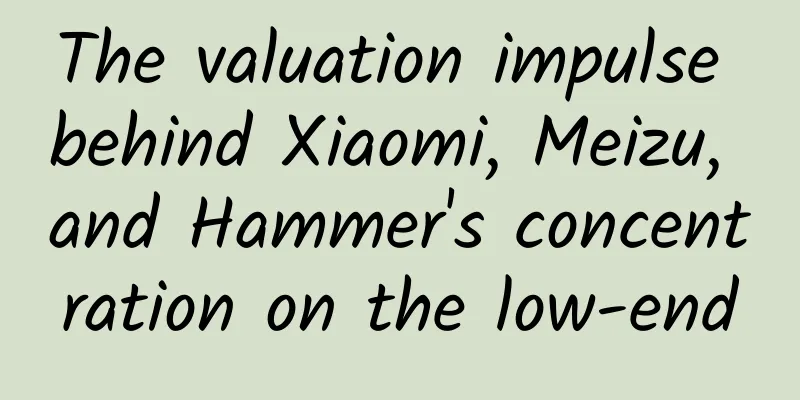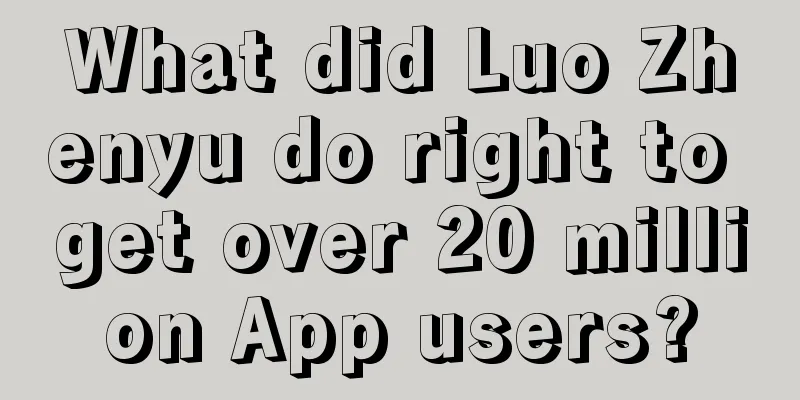The valuation impulse behind Xiaomi, Meizu, and Hammer's concentration on the low-end

|
Yesterday, Smartisan released its 1,000-yuan smartphone brand Nut, which is priced at 899/999 yuan, adding another strong competitor to the domestic 1,000-yuan smartphone market. If we look closely at the major changes in the domestic smartphone market over the past two months or even this year, we can find a strange phenomenon: Internet mobile phone manufacturers have seen a surge in sales in the low-end market, with low-end phones priced at 1,000 yuan becoming mid- to high-end phones, and becoming veritable "real flagships". As a result, there have been jokes in the review circle that "Xiaomi Note is completely beaten by Redmi Note 2" and "Meizu MX 5 is beaten by Meizu Blue Note 2". Constantine, a self-media person, called this phenomenon: flagships to protect image, low-end to protect market, domestic mobile phone development has fallen into a distorted situation. But I prefer to see it as the inevitable result of the strategy of domestic mobile phones represented by Xiaomi, Meizu, and Hammer, which is "disguised as hardware manufacturers, but actually Internet companies". Relying on the sales of thousand-yuan phones is the driving force for Internet companies to pursue high valuations. Before Meizu and Hammer transformed, only Xiaomi was an Internet company. But after Meizu and Hammer transformed from small and beautiful to pursue market volume, in essence, Xiaomi, Meizu and Hammer are now all Internet companies. Lei Jun announced as early as the beginning of Xiaomi's birth that although what Xiaomi does is dependent on mobile phones, it is actually based on the Internet platform. Xiaomi is currently the third largest e-commerce company in China and has built a mobile Internet platform based on MIUI. The mobile phone is just a carrier. We can also see this from the findings of the senior management when Meizu was transforming last year. Huang Zhang said, "MX4 is not going to be sold at a profit." In Huang Zhang's view, what Meizu needs to do now is to use financing to expand its scale, use scale to develop Internet services, and use Internet services to push up the company's stock so that shareholders and employees can get returns. Li Nan concluded that the company began to contact capital, changed the previous way of feeding back research and development through its own product profits, and increased the speed of development through financing; employee shareholding has made the company a popular and stock-based company; from pursuing small and beautiful to prioritizing scale. The same is true for Hammer. At the Geek Park Conference in January this year, we could see that Hammer had abandoned its previous pure hardware route and was transforming to the Internet. Luo Yonghao said in a conversation with the host Zhang Peng: There are a large number of people who want to use our operating system. They prefer our software to hardware, which makes us very happy because we have always been a software-driven enterprise. We do not even rule out licensing our operating system to some manufacturers. Xiaomi, Meizu, and Hammer have all transformed into the Internet, so here comes the question: the valuations of the three are actually determined by software shipments. As a software internet company, valuations are based on user numbers, that is, shipments. It is almost inevitable that they will make great efforts to get involved in low-end phones. Therefore, we can see that the valuations of Xiaomi and Meizu are constantly increasing as their shipments increase. Xiaomi maintains the rhythm of completing financing once a year. After almost every round of financing, its value will "triple". In April 2010, Lei Jun and his team, Morningside Venture Capital, and Qiming Venture Partners invested in Xiaomi; at the end of 2010, another round of financing was completed, with IDG as an investor. The company was valued at US$250 million, and the total financing for the whole year was US$41 million; in December 2011, Xiaomi received US$90 million in financing, with a valuation of US$1 billion; at the end of June 2012, Xiaomi announced a financing of US$216 million, with a valuation of US$4 billion; in August 2013, Xiaomi's new round of financing was valued at US$10 billion. In 2014, Xiaomi's valuation exceeded US$40 billion, a 160-fold increase compared to 2010. In 2015, Xiaomi raised US$1.1 billion with a valuation of US$45 billion, which has reached the level of the world's largest technology companies. Xiaomi's shipments were 400,000 units in 2011, 7.19 million units in 2012, 18.7 million units in 2013, and 60 million units in 2014. We can see from the shipments that Xiaomi's valuation growth curve is almost synchronous with the shipment growth curve. There is also a very critical time node here. After the launch of Redmi in July 2013, Xiaomi's financing and shipments entered a fast lane. According to Geek Park, Xiaomi's Mi 3 and Mi 4 both broke through 10 million units at the end of their product cycles, and the final sales were only 20 million units. However, the Redmi and Redmi Note, which are priced at 1,000 yuan, broke through 10 million units in as short as half a year or as long as 9 months after their release. Currently, the sales of the Redmi series have exceeded 40 million units. Statistics in July this year show that the shipments of Redmi 2A in more than three months have reached 5.1 million units. In other words, Xiaomi's valuation is largely composed of the shipments of the Redmi series. The same is true for Meizu. In the first half of 2015, Meizu sold 8.9 million units, a year-on-year increase of 540%, exceeding the total sales of Meizu in the whole year. Of the 8.9 million data, Meizu Blue sold 5 million units in 6 months, accounting for the majority of sales. In terms of financing and valuation, Meizu was valued at 2 billion yuan in July 2014, and 6 billion yuan in November. In February 2015, one year after Huang Zhang officially returned, Meizu announced that Alibaba Group and Haitong Kaiyuan Fund invested 650 million US dollars in Meizu. This is the first time in Meizu's history that it has introduced strategic investment, and the amount of financing exceeds the total of the first four rounds of Xiaomi's six rounds of financing so far. In July this year, Meizu's first round of financing was completed in June, and its valuation exceeded 20 billion yuan. This is the remarkable achievement made by Meizu after its comprehensive transformation to the Internet. The positioning between Internet companies and high-end products is actually misaligned. Internet companies must lower prices to increase sales, but high-end products are contrary to this demand. This misalignment has actually created the so-called "flagship to maintain image, low-end to maintain market share" vicious circle in the current domestic mobile phone market. Judging from the current market situation, the thousand-yuan phone market is moving down to the hundred-yuan phone market. The price of Xiaomi Redmi series, which was originally 799 yuan in 2013, is gradually dropping to 699, 599 or even 499. This situation has also spread to the 2,000 yuan price range that all companies have tacitly adhered to. In April this year, the 2,000 yuan price range of domestic mobile phones showed signs of loosening. Meizu took the lead in reducing prices, and the prices of mid-range phones such as Xiaomi, Honor, and OnePlus all dropped to around 1,500 yuan, leading to a collective dive in the domestic mid-range phone market. Looking back at Hammer last night, it is certain that the reason behind Hammer Technology's launch of a thousand-yuan phone and its transformation to the Internet was driven more by investors. As Luo said at the Geek Park Conference: Our current investors want us to sell this product without making any profit. So, I don’t necessarily have to compare their prices with ours. But when I don’t make any profit, my price is basically the same as theirs. In Luo Yonghao's words, the company that focused on hardware in the past has become "we have always been a software-driven company." Smartisan Technology has also become what Luo Yonghao said last night: a software company in a hardware shell. |
<<: Can the mobile version of Win 10 break through?
>>: Brain hole: If the world is a game
Recommend
Is oCPC delivery in Dasou a mystery?
Dasou ocpc is a double-edged sword. If used well,...
Baijiahao operation skills, teach you how to quickly pass the novice period?
Baijiahao operation skills. Baijiahao has a novic...
Creative strategies for placing wedding photography information flow ads!
As my country's economy is performing well ov...
How do brands plan their video account matrix?
Recently, we have observed that many brands have ...
How much does it cost to customize the Wuyishan fitness mini program? What is the price for customizing the Wuyishan fitness app?
There are two types of customization for Wuyishan...
Search advertising or social media advertising, which one is better?
When it comes to advertising, especially digital ...
Feed ads not working well? Here are a few hidden optimization tips!
Before starting this article, let’s take a look a...
In-depth analysis: Operational strategies behind product cold start
Cold start - The state of a social product before...
Tencent Holdings' American depositary receipts surged more than 5% on Friday as U.S. companies use WeChat in China
US companies use WeChat in China As the US govern...
Keep user growth tips
The sports and fitness app - Keep, has registered...
Apple offers free replacement program for some iPhone XS, XS Max, and XR smart battery cases
In January 2019, Apple launched a smart battery c...
Audio of 23 educational methods of famous teachers from Beijing No. 4 Middle School
Audio of 23 educational methods of famous teacher...
How is it different from Alipay and WeChat? A detailed experience of the Digital RMB App
Finally, the region where I live has also started...
360 Search Festival Brand Sponsorship, CPT Advertising Promotion Introduction!
360 Festival Brand Sponsorship Introduction to th...
Top 5 tools for cross-platform mobile app development
[51CTO Translation] This article introduces five ...









